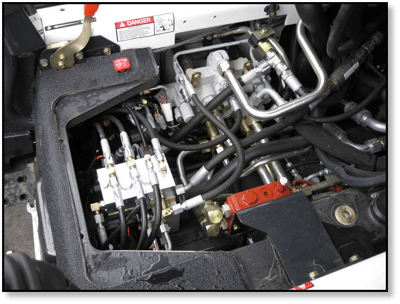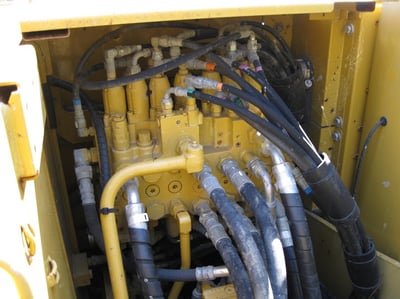Your hydraulic equipment has many different hydraulic connectors, and it’s good to know the different types. In this Shop Talk Blog post, we’ll talk about hydraulic connectors (threaded, flange, and quick disconnect) -- including how they work and where you’re likely to find them.

Here are some other Shop Talk Blog posts you might find of interest:
- 5 Things to Avoid Doing With Hydraulic Lines
- Hydraulic Hoses and Final Drives
- Causes of Hydraulic Hose Failure on Heavy Equipment
Understanding Hydraulic Connectors
Hydraulic connectors are essential parts of the hydraulic system that power your equipment, allowing hydraulic fluid (usually under high pressure) to transmit force and power where needed, including your final drive motors. These connectors are designed to withstand high pressure and ensure a leak-free connection.
Understanding the function and design of hydraulic connectors is extremely helpful for properly operating hydraulic systems. Different hydraulic connectors serve specific purposes and are selected based on the system's requirements, so let's look at the various types.
Common Types of Hydraulic Connectors
Common types of hydraulic connectors include quick couplings, threaded connectors, flange connectors, and push-to-connect fittings. Each type has its unique features and applications, and they can be organized into three basic types:
- Threaded connectors
- Flange connectors
- Quick disconnect connectors
Quick couplings are popular for their fast and easy connection and disconnection, while threaded connectors provide a secure and reliable connection. Flange connectors are commonly used in high-pressure applications, and push-to-connect fittings are convenient for rapid assembly.

Threaded Connectors
National Pipe Thread (NPT) connectors are a standardized type of fitting that joins pipes and fittings and can be found in plumbing, gas lines, and air lines. NPT connectors' applications include plumbing (hot and cold water lines), gas lines (e.g., natural gas and propane), and compressed air lines.
These connectors have tapered threads that are more narrow at the end. The purpose of tapered threads is to create a very tight seal. That’s one of the things that stands out about NPT connectors: they achieve a highly reliable, durable seal. NPT connectors are made from strong, corrosion-resistant steel, brass, and stainless steel.
British Standard Pipe Fitting (BSPP), or British Standard Pipe Mechanical, are parallel thread connectors for pipes and fittings. You’ll find them in the UK, Europe, Asia, Australia, New Zealand, and South Africa. In the United States and Canada, NPT threads are more common. They are found in low-pressure plumbing and gas lines, hydraulic and pneumatic systems, gauges, and instrumentation.
These connectors have a constant diameter along their length and can achieve a tight seal using an appropriately sized o-ring or washer. Their threads are also made from brass, steel, and stainless steel like the NPT connectors. Finally, BSPP connectors are standardized by ISO 228-1 and come in sizes denoted by "G" followed by a number (e.g., G1/4, G1/2, G3/4).
British Standard Pipe Taper (BSPT), also known as Pipe Taper or Conical Thread, uses a tapered thread for connecting pipes and fittings and is used in the same regions as BSPP connectors. Like NPT connectors, they don’t need any extra sealants in most applications and are made from brass, steel, and stainless steel. Like BSPP connectors, they are standardized by ISO 7-1 and come in various sizes denoted by "R" followed by a number (e.g., R1/4, R1/2, R3/4). These connectors are found in steam lines, hydraulic and pneumatic systems, and high-pressure plumbing and gas lines.
BSPP and BSPT threads aren't interchangeable with other thread standards like NPT. There are going to be differences in thread angle, diameter, and pitch -- and a mismatch can lead to damaging leaks.
Flange Connectors
A hydraulic flange connector is an absolutely essential component that you cannot do without in hydraulic systems to connect different sections of pipe, tube, or hose. It ensures that fluids can pass through smoothly and without any leaks, even under high pressure. Unlike traditional connectors that use threaded or compression fittings, hydraulic flange connectors use a flange and bolts to establish an extremely tight and secure connection. This design makes installation and maintenance a breeze compared to other connection methods.
The flange part of the connector typically has a series of holes around its perimeter for bolts to pass through, securing the flange to a mating piece with a similar bolt pattern. This creates a robust seal that can handle the high pressures typical in hydraulic systems. The seal is often reinforced by placing O-rings or gaskets between the flanges to ensure no leakage.
Flange connectors are preferred for their durability, reliability, and ability to maintain a tight seal under varying pressure and temperature conditions.
Blind Flanges: These are solid discs that blank off a piping system's end or seal an opening. It's used for isolating sections of a hydraulic system or when future expansions are considered.
Captive Flanges: This type of flange is integrated into the hose fitting for a very secure connection capable of handling high pressures. You’ll see these in high-vibration or high-pressure applications.
Integral Flanges: These flanges are manufactured as a single piece with the hose fitting, providing a strong and leak-proof connection. They are commonly used in high-pressure applications where a reliable connection is essential.
Lap joint flanges: These flanges consist of two halves that clamp around the stub ends of a pipe. They are a good choice for applications where it is necessary to disassemble the joint frequently or when made from a material that is difficult to weld.
SAE Flanges (Code 61 & Code 62): These are designed according to the Society of Automotive Engineers (SAE) standards. Code 61 refers to standard-pressure flanges, while Code 62 designates high-pressure flanges. These are commonly used because of their reliable sealing capability and ease of assembly.
Screwed flanges: These flanges screw onto the threaded end of the pipe and work well for low-pressure applications
Slip-on flanges: These are slipped over the end of the pipe and then welded to the pipe wall and are a good choice for applications where it is difficult to weld directly to the pipe.
Socket Weld Flanges: These are inserted into a recessed area of a valve, fitting, or pipe before welding. You’ll see them used on smaller pipe diameters in high-pressure applications.
Split Flanges: These consist of two halves bolted around the hydraulic hose or tube. Their design makes them easier to install and maintain in tight spaces or when large-diameter tubes or hoses are involved.
Square Flanges: Square flanges are used in systems requiring four-bolt flanges and requiring high pressure.
Threaded Flanges: These are screwed directly onto a pipe without welding and are used when welding is not possible.
Weld neck flanges: These flanges are welded directly to the pipe, providing a strong and leak-proof connection., and are often used in high-pressure applications.
Quick Disconnect Connectors
Quick disconnect connectors are also called quick couplings or quick-release couplings. Their job is facilitating easy, fast, and secure connections and disconnections of hoses and pipes without tools or specialized equipment. These connectors are essential in systems requiring frequent disconnection and reconnection of components, supporting flexibility, maintenance, and the ability to change or isolate parts of the system quickly.

There are several quick disconnect connectors, each designed for specific applications and pressures:
Flat Face: These are engineered to eliminate spillage and air inclusion when connecting and disconnecting -- which can be extremely important from a hydraulic cleanliness viewpoint. They are ideal for applications requiring minimal contamination, such as in clean environments or with sensitive hydraulic circuits.
High-Pressure: as their name implies, these quick disconnects are used with extreme pressures They often feature robust construction and locking mechanisms to ensure a secure connection under high pressure.
ISO A (ISO 7241-1 Series A and B): These are widely used thanks to a poppet valve design that minimizes leakage during disconnections and connections. They are versatile and can be used in various hydraulic systems. The B series is similar to ISO A but with a slightly different profile, the ISO B connectors are also widely used and feature a poppet valve design. They are interchangeable with other ISO B connectors and are easy to clean and can minimize fluid spillage.
Series B is used predominantly in North America and the chemical industry, while Series A is mainly used in Europe and is preferred worldwide for agricultural and forestry machinery.
Push-Pull: Push-pull quick disconnect connectors are for easy connection and disconnection; just push or pull the connector halves. They are user-friendly and often used in applications requiring quick and frequent changes.
Screw Type: These use a threaded connection and are known for their ability to withstand high pressures and vibrations, making them suitable for heavy-duty applications.
Snap Type: These hydraulic connectors use a ball lock mechanism to connect and disconnect quickly. They are easy to use and provide a secure connection, suitable for low- to medium-pressure applications.
Wing Nut: Wing nut connectors are designed for frequent manual connection and disconnection. The wing nut allows easy tightening and loosening without needing tools.
Factors to Consider When Choosing Hydraulic Connectors
When selecting hydraulic connectors, make sure to consider compatibility, pressure rating, material, size, and fitting type. Choosing the right hydraulic connector ensures optimal performance and safety. It's crucial to look at the specific requirements of the hydraulic system and select connectors that meet those needs.
Maintenance and Safety Tips for Hydraulic Connectors
Proper maintenance of hydraulic connectors is essential to prevent leaks, contamination, and system failures. Regular inspections, cleaning, and lubrication can help prolong connectors' lifespan and ensure reliable performance. However, safety precautions should be followed when working with hydraulic connectors, such as wearing appropriate personal protective equipment and following proper installation procedures. Training on hydraulic system maintenance and safety is crucial for preventing accidents and injuries.


